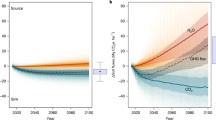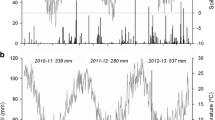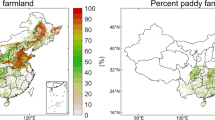Abstract
The Denitrification-Decompostion (DNDC) model was used to estimate the impact of change in management practices on N2O emissions in seven major soil regions in Canada, for the period 1970 to 2029. Conversion of cultivated land to permanent grassland would result in the greatest reduction in N2O emissions, particularly in eastern Canada wherethe model estimated about 60% less N2O emissions for thisconversion. About 33% less N2O emissions were predicted for a changefrom conventional tillage to no-tillage in western Canada, however, a slight increase in N2O emissions was predicted for eastern Canada. GreaterN2O emissions in eastern Canada associated with the adoption of no-tillage were attributed to higher soil moisture causing denitrification, whereas the lower emissions in western Canada were attributed to less decomposition of soil organic matter in no-till versus conventional tilled soil. Elimination of summer fallow in a crop rotation resulted in a 9% decrease in N2O emissions, with substantial emissions occurringduring the wetter fallow years when N had accumulated. Increasing N-fertilizer application rates by 50% increased average emissions by 32%,while a 50% decrease of N-fertilizer application decreased emissions by16%. In general, a small increase in N2O emissions was predicted when N-fertilizer was applied in the fall rather than in the spring. Previous research on CO2 emissions with the CENTURY model (Smith et al.,2001) allowed the quantification of the combined change in N2O andCO2 emissions in CO2 equivalents for a wide range of managementpractices in the seven major soil regions in Canada. The management practices that have the greatest potential to reduce the combined N2O andCO2 emissions are conversion from conventional tillage to permanent grassland, reduced tillage, and reduction of summer fallow. The estimated net greenhouse gas (GHG) emission reduction when changing from cultivated land to permanent grassland ranged from 0.97 (Brown Chernozem) to 4.24 MgCO2 equiv. ha−1 y−1 (BlackChernozem) for the seven soil regions examined. When changing from conventional tillage to no-tillage the net GHG emission reduction ranged from 0.33 (Brown Chernozem) to 0.80 Mg CO2 equiv. ha−1 y−1 (Dark GrayLuvisol). Elimination of fallow in the crop rotation lead to an estimated net GHG emission reduction of 0.43 (Brown Chernozem) to 0.80 Mg CO2 equiv.ha−1 y−1 (Dark Brown Chernozem). The addition of 50% more or 50% less N-fertilizer both resulted in slight increases in combined CO2 and N2O emissions. There was a tradeoff in GHG flux with greaterN2O emissions and a comparable increase in carbon storage when 50% more N-fertilizer was added. The results from this work indicate that conversion of cultivated land to grassland, the conversion from conventional tillage to no-tillage, and the reduction of summerallow in crop rotations could substantially increase C sequestration and decrease net GHG emissions. Based on these results a simple scaling-up scenario to derive the possible impacts on Canada's Kyoto commitment has been calculated.
Similar content being viewed by others
References
Ball, B. C., Scott, A., and Parker, J. P.: 1999, ‘Field N2O, CO2, and CH4 Fluxes in Relation to Tillage, Compaction and Soil Quality in Scotland’, Soil Tillage Res. 53, 29–39.
Bouwman, A. F.: 1990, ‘Exchange of Greenhouse Gases between Terrestrial Ecosystems and the Atmosphere’, in Bouwman, A. F. (ed.), Soils and the Greenhouse Effect, John Wiley and Sons, Chichester, England, pp. 61–127.
Boehm, M., Junkins, B., Desjardins, R., Kulshreshtha, S., and Lindwall, W.: 2003, 'Sink Potential of Canadian Agricultural Soils’, (this issue).
CanSIS (Canadian Soil Information System): 2003, 'Major Soil Regions of Canada', Agriculture and Agri-Food Canada, retrieved from http://sis.agr.gc.ca/cansis/publications/health/frontin.html.
Choudhary, M. A., Akramkhanov, A., and Saggar, S.: 2001, ‘Nitrous Oxide Emissions in Soils Cropped with Maize under Long-term Tillage and under Permanent Pasture in New Zealand’, Soil Tillage Res. 62, 61–71.
Choudhary, M. A., Akramkhanov, A., and Saggar, S.: 2002, ‘Nitrous Oxide Emissions from a New Zealand Cropped Soil: Tillage Effects, Spatial and Seasonal Variability’, Agricult. Ecosyst.Environ. 1931, 1–11.
Conant, R. T., Paustian, K., and Elliott, E. T.: 2001, ‘Grassland Management and Conversion into Grassland: Effects on Soil Carbon’, Ecol. Appl. 11(2), 343–355.
Desjardins, R. L. and Riznek, R.: 2000, ‘Agricultural Greenhouse Gas Budget’, in McRae, T., Smith, C. A. S., and Gregorich, L. J. (eds.), Environmental Sustainability of Canadian Agriculture: Report of the Agri-Environmental Indicator Project, Catalogue No. A22-201/2000E, Agriculture and Agri-Food Canada, Ottawa, Ontario, pp. 133–142.
Eichner, M. J.: 1990, ‘Nitrous Oxide Emissions from Fertilized Soils: Summary of Available Data’, J. Environ. Qual. 19, 272–280.
Follet, R. F. and McConkey, B.: 2000, ‘The Role of Cropland Agriculture for C Sequestration in the Great Plains’, In Proceedings of the Conference on Great Plains Soil Fertility, Vol. 8, pp. 1–15.
Granli, T. and Bockman, O. C.: 1994, ‘Nitrous Oxide from Agriculture’, Norw. J. Agric. Sci. Suppl. 12, 48–53.
IPCC: 2001, Climate Change 2001: The Scientific Basis. Contribution of Working Group I to the Third Assessment Report of the Intergovernmental Panel on Climate Change, Houghton, J. T., Ding, Y., Griggs, D. J., Noguer, M., v.d. Linden, P. J., Dai, X., Maskell, K., and Johnson, C. A. (eds.), Cambridge University Press, p. 881.
Janzen, H. H., Campbell, C. A., Izaurralde, R. C., Ellert, B. H., Juma, N., McGill, W. B., and Zentner, R. P.: 1998a, ‘Management Effects on Soil C Storage on the Canadian Prairies’, Soil Till. Res. 47, 181–195.
Janzen, H. H., Campbell, C. A., Gregorich, E. G., and Ellert, B. H.: 1998b, ‘Soil Carbon Dynamics in Canadian Agroecosystems’, in Lal, R., Kimble, J., Follett, R., and Stewart, B. A. (eds.), Soil Processes and Carbon Cycles, CRC Press, Boca Raton, FL, pp. 57–80.
Korol, M. and Girard, L.: 1996, Canadian Fertilizer Consumption, Shipments and Trade 1994/95, Farm Income Policy and Programs Directorate, Agriculture and Agri-Food Canada, Ottawa, Ontario.
Lal, R. and Bruce, J. P.: 1999, ‘The Potential of World Cropland Soils to Sequester C and Mitigate the Greenhouse Effect’, Environ. Sci. Pol. 2(2), 177–185.
Li, C., Frolking, S., and Frolking, T. A.: 1992a, ‘A Model of Nitrous Oxide Evolution from Soil Driven by Rainfall Events: 1. Model Structure and Sensitivity’, J. Geophys. Res. 97, 9759–9776.
Li, C., Frolking, S., and Frolking, T. A.: 1992b, ‘A Model of Nitrous Oxide Evolution from Soil Driven by Rainfall Events: 2. Model Applications’, J. Geophys. Res. 97, 9888–9783.
Li, C., Frolking, S., and Harriss, R.: 1994. ‘Modeling Carbon Biogeochemistry in Agricultural Soils’, Global Biogeochem. Cycles 8, 237–254.
Li, C., Frolking, S., Crocker, G. J., Grace, P. R., Klir, J., Korchens, M., and Poulton, P. R.: 1997, ‘Simulating Trends in Soil Organic Carbon in Long-term Experiments Using the DNDC Model’, Geoderma 81, 45–60.
Li, C.: 2000, ‘Modeling Trace Gas Emissions from Agricultural Ecosystems', Nutrient Cycling Agroecosyst. 58, 259–276.
Li, C., Zhuang, Y., Cao, M., Crill, P., Dai, Z., Frolking, S., Moore III, B., Salas, W., Song, W., and Wang, X.: 2001, ‘Comparing a Process-based Agro-ecosystem Model to the IPCC Methodology for Developing a National Inventory of N2O Emissions from Arable Lands in China’, Nutrient Cycling Agroecosyst. 60, 159–175.
Lemke, R. L., Izaurralde, R. C., Nyborg, M., and Solberg, E. D.: 1999, ‘Tillage and N-source In-fluence Soil-emitted Nitrous Oxide in the Alberta Parkland Region’, Can. J. Soil Sci. 79(1), 15–24.
Lemke, R. L., McConkey, B. G., Izaurralde, R. C., Goddard, T. W., Selles, F., Campbell, C. A., Boehm, M., and Lindwall, C. W.: 2001, ‘Reduced Tillage: Can It Help Conserve Soils and Reduce Greenhouse Gas Emissions from Western Canadian Agriculture?’, in Wei et al. (eds.), Promoting Global Innovation of Agricultural Science and Technology and Sustainable Agricultural Development, Proceedings of the International Conference on Agricultural Science and Technology, Nov. 7-9, Beijing, China, pp. 302–306 (session 3: Resources and Environment).
Manuela, R., Heinemeyers, O., Munch, J. C., and Kaiser, E. A.: 1999, ‘Spatial Heterogeneity within the Plough Layer: High Variability of N2O Emission Rates’, Soil Biol. Biochem. 31, 167–173.
Malhi, S. S., Grant, C. A., Johnston, A. M., and Gill, K. S.: 2001, ‘Nitrogen FertilizationManagement for No-till Cereal Production in the Canadian Great Plains: A Review’, Soil Till. Res. 60, 101–122.
Mosier, A. R.: 1994, ‘Nitrous Oxide Emissions from Agricultural Soils’, Fert. Res. 38, 191–200.
Rudaz, A. O., Walti, E., Kyburz, G., Lehmann, P., and Fuhrer, J.: 1999, ‘Temporal Variation in N2O and N2 Fluxes from a Permanent Pasture in Switzerland in Relation to Management, Soil Water Content and Soil Temperature’, Agricult. Ecosyst. Environ. 73, 83–91.
Skiba, U. and Smith, K. A.: 2000, ‘The Control of Nitrous Oxide Emissions from Agricultural and Natural Soils’, Chemosphere-Global Change Sci. 2, 379–386.
Smith, W., Desjardins, R. L., and Pattey, E.: 2000, ‘The Net Flux of Carbon from Agricultural Soils in Canada 1970-2010’, Global Change Biol. 6, 557–568.
Smith, W. N., Desjardins, R. L., and Grant, B.: 2001, ‘Estimated Changes in Soil Carbon Associated with Agricultural Practices in Canada’, Can. J. Soil Sci. 81, 221–227.
Smith, W. N., Desjardins, R. L., Grant, B., Li, C., Corre, M., Rochette, P., and Lemke, R.: 2002, ‘Testing the DNDC Model Using N2O Emissions at Two Experimental Sites’, Can. J. Soil Sci. 82, 365–374.
Walsh, L. M.: 1970, ‘Let's Take Another Look at Autumn Fertilizing’, Crops Soils 22, 8–9.
Watson, R. T., Rodhe, H., Oeschger, H., and Siegenthaler, U.: 1990, ‘Greenhouse Gases and Aerosols’, in Houghton, J. T., Jenkins, G. J., and Ephraums, J. J. (eds.), Climate Change: The IPCC Scientific Assessment, Cambridge University Press, U.K., p. 365.
VandenBygaart, A. J., Gregorich, E. G., and Angers, D. A.: 2003, ‘Influence of Agricultural Management on Soil Organic Carbon: A Compendium and Assessment of Canadian Studies’, Can.J. Soil Sci., submitted. (Received 10 September 2002; in revised form 5 December 2003)
Author information
Authors and Affiliations
Rights and permissions
About this article
Cite this article
Grant, B., Smith, W.N., Desjardins, R. et al. Estimated N2O and CO2 Emissions as Influenced by Agricultural Practices in Canada. Climatic Change 65, 315–332 (2004). https://doi.org/10.1023/B:CLIM.0000038226.60317.35
Issue Date:
DOI: https://doi.org/10.1023/B:CLIM.0000038226.60317.35




